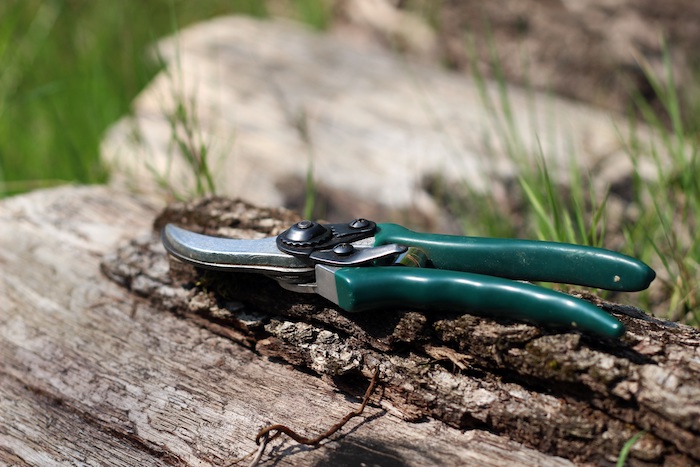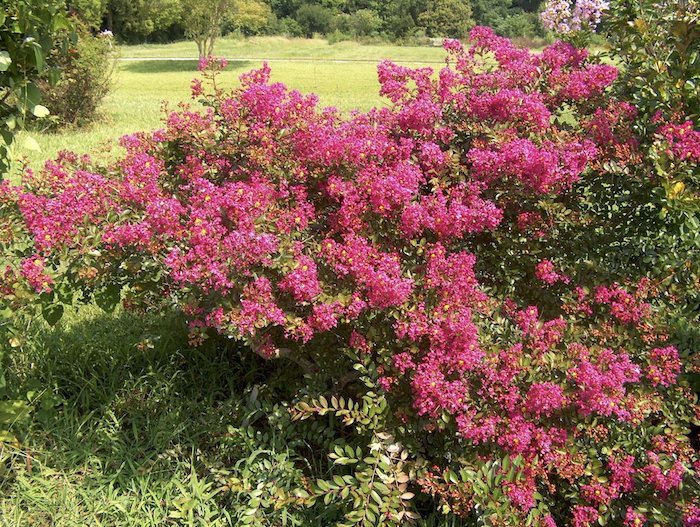
A well-pruned crepe myrtle tree is an excellent centerpiece for a beautiful yard. However, the way you prune and maintain your crepe myrtle trees makes the difference between an average looking tree and one that is genuinely stunning.
Do you have a crepe myrtle tree but aren’t sure how to properly care for it? Well, you are in luck because the team of experts at Lawn Love has compiled this information detailing why you need to prune your crepe myrtle tree and how to do it.
What is a crepe myrtle tree?
Crepe myrtle trees are small trees or shrubs that people plant on their yards for ornamental purposes. The trees can grow to a height of up to 30 feet, and they produce a lot of large flowers during the summer.
Crepe myrtle trees grow well in warmer regions, which explains why they are common in the Southeast states. You can easily identify these trees because of their distinct features such as mottled, peeling barks, and multiple trunks. Pruning these trees is imperative because they start blooming from new growth. To keep your yard looking great, you have to go about the pruning procedure correctly.ad
Reasons for pruning a crepe myrtle tree
Besides improving the aesthetic quality of your yard, there are various reasons for you to consider pruning your myrtle trees.
- You should prune to eliminate small and low-hanging limbs, or else they may grow to cover your lawn or pathway over time.
- You should prune to remove the limbs that rub against one another.
- It helps to eliminate deadwood.
- You should prune to get rid of twigs and limbs that tend to grow back towards the center of your crepe myrtle tree.
- You can prune to remove the suckers that come up from the trees’ base.
- You should prune to remove side branches that are longer than 4 feet from the main trunk.
When is the ideal time to prune?
To retain the ornamental value of your myrtle tree, you must cut it at the correct time. We recommend pruning during late winter. Crepe myrtle trees are leafless during this season. As a result, you can easily access and see all the branches, thus allowing you to cut them accordingly. Furthermore, pruning does not affect blooming because these trees or shrubs bloom on new growth.

Proper crepe myrtle pruning tools
When it comes to pruning a crepe myrtle bush or tree, it is essential to have the appropriate tools. Fortunately, all required tools can be found at your local hardware store. They include:
Hand pruners – we recommend using these pruning tools for clipping branches and twigs that are less than a ½-inch thick.
Loppers – we recommend using these tools to prune crepe myrtles that have branches that measure from ½-inch to 1 ½-inches thick.
Pruning saw, or pole pruners – these tools are appropriate for cutting branches that are more than 1 ½-inches thick.
What is crepe murder?
What is crepe murder? That’s one of the most common questions that we come across from people who would like to prune their crepe myrtle tree(s). It is the term given to the act of cutting or pruning crepe myrtle trees back to leave a few tall stumps. When you cut back your trees in this manner, their new growth has knotty bumps, plus the growth is tightly arranged.
Your tree may become deformed if you repeat this pruning procedure every year. You may not notice this deformed effect during summer when the leaves and flowers have blossomed. However, you can easily identify an overly pruned crepe myrtle tree during winter because the trees have shed the leaves and are bare.

If you wish to correct crepe murder, the best solution is to cut your tree to the ground so that it can start over. Luckily, these trees are resilient enough and are capable of blossoming with every new growth. Here are some more reasons why crepe murder is ill-advised:
- It inhibits the formation of beautiful, mottled barks on the trunks of the trees.
- It turns your ornamental tree into unattractive stumps.
- It causes the branches to bend because the limbs are too weak to hold the flowers firmly.
Shrub crepe myrtles
A crepe myrtle bush does not grow as tall as a crepe myrtle tree. It only grows a few feet above the ground. As a result, crepe myrtle bush pruning is different from pruning a tree. We recommend having a shrub type of crepe myrtle to people who desire a smaller plant.
Crepe myrtle bush pruning is imperative because the bushes can overgrow, occupying much space and eventually spreading to unwanted areas. Keep in mind that pruning a crepe myrtle bush has to be done correctly for the plant to retain its ornamental appeal.

How to Cut a Dwarf Crepe Myrtle Tree
Dwarf crepe myrtle pruning also differs from pruning a standard crepe myrtle tree. People often go for the dwarf type of crepe myrtle when they have smaller gardens, but wish to have a beautiful plant growing on it.
Dwarf crepe myrtle pruning is not a complicated process although it might be hectic to some people. As a result, most people hardly prune the dwarf myrtle trees because they have a slow growth rate. However, when you notice some overgrowth, it’s time to do some clipping.
If your dwarf crepe myrtle tree has become dense, we recommend pruning it during late winter or early spring. This allows the new leaves to emerge seamlessly.
Alternatively, you can conduct deadheading – the process of removing faded flowers. Deadheading is mostly recommended during summer to allow the flowers to bloom. We advise using a hand pruner for this process.
How to prune crepe myrtle trees
Have you been thinking about pruning your crepe myrtle trees? If you have, we’ll have you know that there are specific tactics and procedures that you need to employ to ensure that your operation is successful. Here, we will walk you through a step-by-step guide on how to properly prune a crepe myrtle tree.
1. Have the correct equipment
Before you commence your task, you must make sure that you have all the necessary tools for the task ahead. Earlier in this guide, we had mentioned some of the tools that are used in pruning this type of trees. If you don’t have the equipment in your garage, you can purchase some from the hardware store.
2. Prune during early spring or late winter
We recommend pruning during late winter or early spring. These seasons work well for crepe myrtle trees because they bloom on new growth. During the winter, the trees are bare, which means that they are in their dormant stage. This means that when you prune the trees during this period, new branches and leaves will grow when the trees come out of the dormant stage.
We advise against pruning during fall because it can affect the year’s new growth. It is wise to prune at a time that will leave your trees with enough time to blossom and grow during the growing season.
Additionally, pruning during late winter and early spring allows you to see the branches that need to be trimmed easily. You can also carry out deadheading during the summer to promote the second bloom of flowers.
3. Establish the size and shape that you would want your crepe myrtle to take
Another critical step that you must consider before pruning is determining the size and style that you would love your plant to take. Mostly, we tell people to cut their plants with the aim of creating more space towards the center of the tree so that air can flow through more freely. Doing so encourages the growth of a healthy and attractive plant.
You should refrain from over-pruning. This means that you shouldn’t cut back the tree’s trunk close to the ground. Focus more on the branches. You can also prune depending on the shape and size that works best for you. If you have a large yard, you can prune your crepe myrtle trees to have a taller height and vice versa. Do not severely butcher your tree(s).
4. Assess how your crepe myrtle tree is growing
Before settling on a pruning method and style, you need to observe how the plant grows. You must keep in mind that crepe myrtle trees blossom on every new growth. This means that they grow wider and taller every year. You, therefore, need to prune your tree in a manner that doesn’t compromise the tree’s shape. We recommend looking at pictures of lightly pruned crepe myrtle trees so that you can follow the same procedure.
5. Cut the suckers
When you get down to trimming, you have to make sure to prune the suckers. Suckers are the thin, new sprouts; to prune them, you should begin with the ones situated at the bottom of the tree. The suckers can give your tree a bushy appearance, which compromises its ornamental value. Additionally, the small sprouts compete with the main trunk for essential nutrients. That’s why it’s crucial to cut them as soon as they appear. A hand pruner does the job perfectly.
6. Remove the side branches
Next up, you need to eliminate the branches that protrude from the side of the main trunk. You have to prune the branches that have overgrown in height and those that give the tree an undesirable shape. Doing so ensures that your crepe myrtle tree maintains an attractive shape. Most importantly, you must cut the branches that appear to be growing back towards the center of the tree.
7. Cut out dead and crossing branches
Cut away any crossing or dead branches. These branches distort the shape of the tree and must be removed every year.
8. Observe the color of the flowers
The crepe myrtle tree has plenty of varieties. This means that they feature different colors and growing patterns, and this affects how each plant is to be trimmed. When the plant is blossoming, be sure to look at the overall color, and shape of your tree to establish the best approach for pruning it.
Conclusion
The crepe myrtle tree is a popular tree across the United States, and it is typically planted for its aesthetic value. However, you must prune it from time to time to retain this attractiveness. Keep in mind that there are different varieties of myrtle trees, and each requires a different approach. With this guide, however, you are well on your way to maintaining a beautiful crepe myrtle tree.